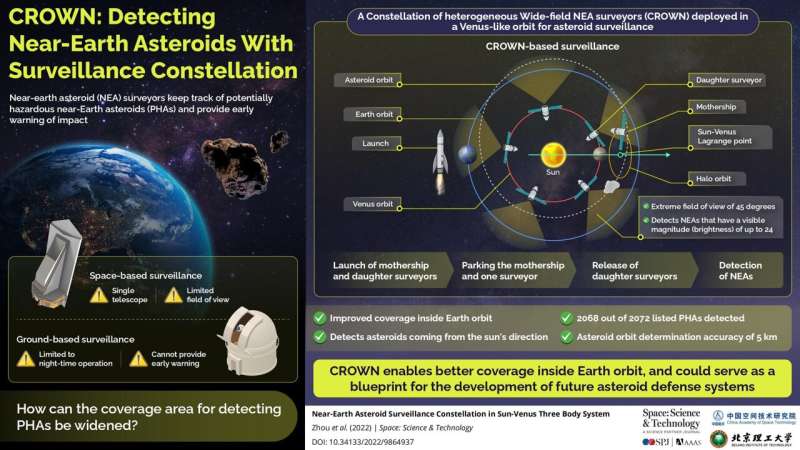A proposal for monitoring potentially hazardous near-Earth asteroids

An enormous number of near-Earth asteroids (NEAs) orbit around the sun, and among them, 2,072 NEAs are recorded in the Minor Planet Center (MPC) database as potential hazardous near-Earth asteroids (PHAs). These PHAs frequently make close approaches to Earth's orbit, and therefore, the hazard caused by PHAs is still a very real and ever-present threat. Faced with potential threats of PHA impacts, asteroid defense has been discussed with growing interest. Monitoring for and early warning about those PHAs is the premise of planetary defense.
In a research paper recently published in Space: Science & Technology, Xiangyu Li, from the School of Aerospace Engineering, Beijing Institute of Technology, and co-authors propose the novel concept of a surveillance constellation of heterogeneous wide-field near-Earth asteroid (NEA) surveyors (CROWN), in which six space-based surveyors would be loosely deployed in Venus-like orbits to detect the NEAs along the direction of the sunlight.
The authors discuss the concept and overall design of the NEA surveillance constellation. Generally, an asteroid defense system should obey the circle of OODA, which includes observation, orientation, decision, and action.
The proposed CROWN would be a key part of the asteroid defense system, which would be mainly responsible for observation and orientation, i.e., the detection and early warning of the PHAs and tracking and orbit determination (OD) of the target. The surveillance constellation would contain a mother ship and six daughter surveyors (space-based optical telescopes).
The mother ship would provide the maneuverability required for transfer and deployment. Six daughter surveyors would be loosely deployed on Venus-like orbits, and would be equipped with the telescopes pointing backward to the sun to detect NEAs approaching from the sun's direction.
Moreover, the methods and aspects for evaluating the performance of the proposed CROWN are presented. In general, the performance of a surveillance constellation can be evaluated in aspects of the constellation, the surveyor, and the payload. For each aspect, both the ability and the cost are considered.
For the constellation, the abilities include the surveillance convergence and the OD performance. The costs of the constellation would contain the energy required for transfer, deployment, and maintenance. The performance of a single surveyor could be evaluated by the life-circle costs and the relatively favorable cost/benefit ratios. The performance indexes of the payload include the sensitivity, accuracy, power consumption, and the price.
In closing, the authors introduce the overall mission of the CROWN, which includes four stages.
More information: Xingyu Zhou et al, Near-Earth Asteroid Surveillance Constellation in the Sun-Venus Three-Body System, Space: Science & Technology (2022). DOI: 10.34133/2022/9864937
Provided by Beijing Institute of Technology Press Co., Ltd
















